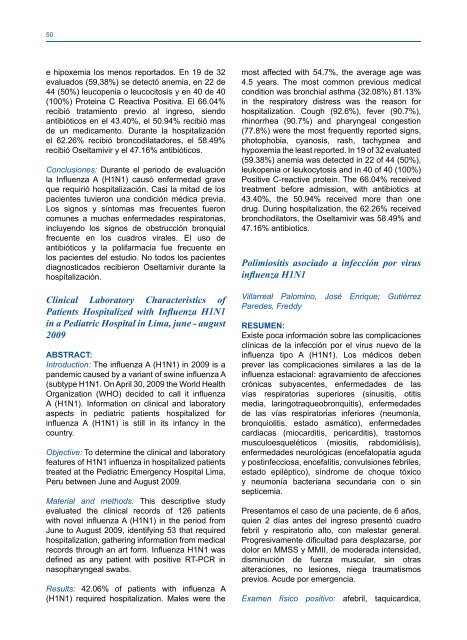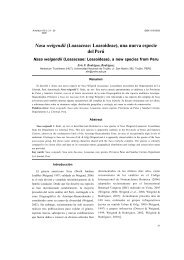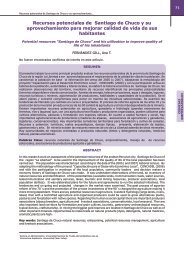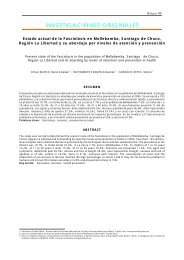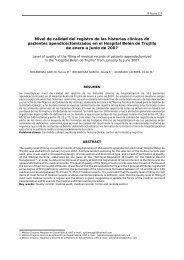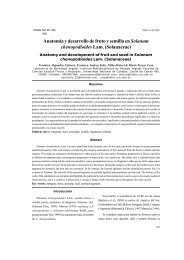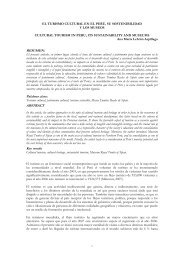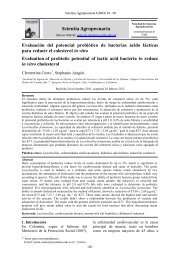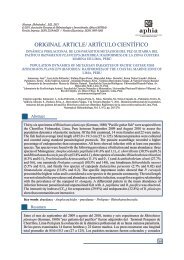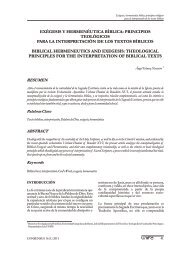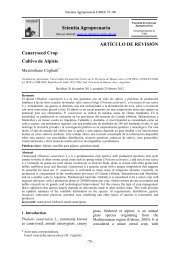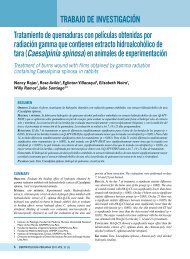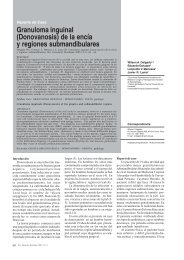temas libres presentados en el xxvi congreso ... - Revista Peruana
temas libres presentados en el xxvi congreso ... - Revista Peruana
temas libres presentados en el xxvi congreso ... - Revista Peruana
You also want an ePaper? Increase the reach of your titles
YUMPU automatically turns print PDFs into web optimized ePapers that Google loves.
50e hipoxemia los m<strong>en</strong>os reportados. En 19 de 32evaluados (59.38%) se detectó anemia, <strong>en</strong> 22 de44 (50%) leucop<strong>en</strong>ia o leucocitosis y <strong>en</strong> 40 de 40(100%) Proteina C Reactiva Positiva. El 66.04%recibió tratami<strong>en</strong>to previo al ingreso, si<strong>en</strong>doantibióticos <strong>en</strong> <strong>el</strong> 43.40%, <strong>el</strong> 50.94% recibió masde un medicam<strong>en</strong>to. Durante la hospitalización<strong>el</strong> 62.26% recibió broncodilatadores, <strong>el</strong> 58.49%recibió Os<strong>el</strong>tamivir y <strong>el</strong> 47.16% antibióticos.Conclusiones: Durante <strong>el</strong> periodo de evaluaciónla Influ<strong>en</strong>za A (H1N1) causó <strong>en</strong>fermedad graveque requirió hospitalización. Casi la mitad de lospaci<strong>en</strong>tes tuvieron una condición médica previa.Los signos y síntomas mas frecu<strong>en</strong>tes fueroncomunes a muchas <strong>en</strong>fermedades respiratorias,incluy<strong>en</strong>do los signos de obstrucción bronquialfrecu<strong>en</strong>te <strong>en</strong> los cuadros virales. El uso deantibióticos y la polifarmacia fue frecu<strong>en</strong>te <strong>en</strong>los paci<strong>en</strong>tes d<strong>el</strong> estudio. No todos los paci<strong>en</strong>tesdiagnosticados recibieron Os<strong>el</strong>tamivir durante lahospitalización.Clinical Laboratory Characteristics ofPati<strong>en</strong>ts Hospitalized with Influ<strong>en</strong>za H1N1in a Pediatric Hospital in Lima, june - august2009ABSTRACT:Introduction: The influ<strong>en</strong>za A (H1N1) in 2009 is apandemic caused by a variant of swine influ<strong>en</strong>za A(subtype H1N1. On April 30, 2009 the World HealthOrganization (WHO) decided to call it influ<strong>en</strong>zaA (H1N1). Information on clinical and laboratoryaspects in pediatric pati<strong>en</strong>ts hospitalized forinflu<strong>en</strong>za A (H1N1) is still in its infancy in thecountry.Objective: To determine the clinical and laboratoryfeatures of H1N1 influ<strong>en</strong>za in hospitalized pati<strong>en</strong>tstreated at the Pediatric Emerg<strong>en</strong>cy Hospital Lima,Peru betwe<strong>en</strong> June and August 2009.Material and methods: This descriptive studyevaluated the clinical records of 126 pati<strong>en</strong>tswith nov<strong>el</strong> influ<strong>en</strong>za A (H1N1) in the period fromJune to August 2009, id<strong>en</strong>tifying 53 that requiredhospitalization, gathering information from medicalrecords through an art form. Influ<strong>en</strong>za H1N1 wasdefined as any pati<strong>en</strong>t with positive RT-PCR innasopharyngeal swabs.Results: 42.06% of pati<strong>en</strong>ts with influ<strong>en</strong>za A(H1N1) required hospitalization. Males were themost affected with 54.7%, the average age was4.5 years. The most common previous medicalcondition was bronchial asthma (32.08%) 81.13%in the respiratory distress was the reason forhospitalization. Cough (92.6%), fever (90.7%),rhinorrhea (90.7%) and pharyngeal congestion(77.8%) were the most frequ<strong>en</strong>tly reported signs,photophobia, cyanosis, rash, tachypnea andhypoxemia the least reported. In 19 of 32 evaluated(59.38%) anemia was detected in 22 of 44 (50%),leukop<strong>en</strong>ia or leukocytosis and in 40 of 40 (100%)Positive C-reactive protein. The 66.04% receivedtreatm<strong>en</strong>t before admission, with antibiotics at43.40%, the 50.94% received more than onedrug. During hospitalization, the 62.26% receivedbronchodilators, the Os<strong>el</strong>tamivir was 58.49% and47.16% antibiotics.Polimiositis asociado a infección por virusinflu<strong>en</strong>za H1N1Villarreal Palomino, José Enrique; GutiérrezParedes, FreddyRESUMEN:Existe poca información sobre las complicacionesclínicas de la infección por <strong>el</strong> virus nuevo de lainflu<strong>en</strong>za tipo A (H1N1). Los médicos deb<strong>en</strong>prever las complicaciones similares a las de lainflu<strong>en</strong>za estacional: agravami<strong>en</strong>to de afeccionescrónicas subyac<strong>en</strong>tes, <strong>en</strong>fermedades de lasvías respiratorias superiores (sinusitis, otitismedia, laringotraqueobronquitis), <strong>en</strong>fermedadesde las vías respiratorias inferiores (neumonía,bronquiolitis, estado asmático), <strong>en</strong>fermedadescardiacas (miocarditis, pericarditis), trastornosmusculoesqu<strong>el</strong>éticos (miositis, rabdomiólisis),<strong>en</strong>fermedades neurológicas (<strong>en</strong>cefalopatía aguday postinfecciosa, <strong>en</strong>cefalitis, convulsiones febriles,estado epiléptico), síndrome de choque tóxicoy neumonía bacteriana secundaria con o sinsepticemia.Pres<strong>en</strong>tamos <strong>el</strong> caso de una paci<strong>en</strong>te, de 6 años,qui<strong>en</strong> 2 días antes d<strong>el</strong> ingreso pres<strong>en</strong>tó cuadrofebril y respiratorio alto, con malestar g<strong>en</strong>eral.Progresivam<strong>en</strong>te dificultad para desplazarse, pordolor <strong>en</strong> MMSS y MMII, de moderada int<strong>en</strong>sidad,disminución de fuerza muscular, sin otrasalteraciones, no lesiones, niega traumatismosprevios. Acude por emerg<strong>en</strong>cia.Exam<strong>en</strong> físico positivo: afebril, taquicardica,


